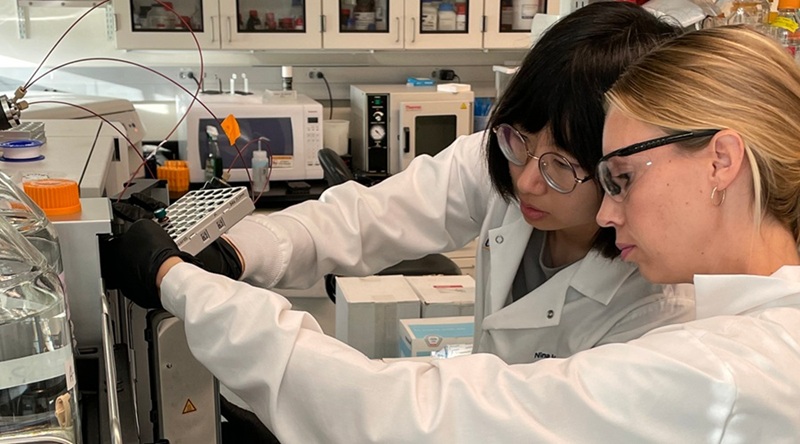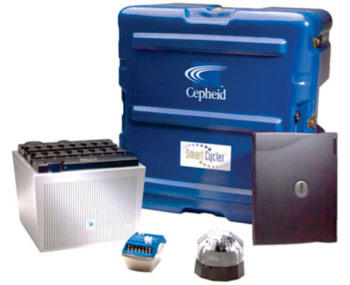Whole Blood DNA Extraction Methods Compared
|
By LabMedica International staff writers Posted on 14 Aug 2014 |
In the clinical laboratory, nucleic acids are routinely isolated from various types of specimen, including blood, sputum, cerebrospinal fluid, stool, urine, buccal swabs, and respiratory specimens, for use in a wide array of molecular diagnostic tests.
Both the quality and quantity of the extracted nucleic acids are crucial to the successful implementation of downstream molecular diagnostic procedures, including polymerase chain reaction (PCR), quantitative PCR, microarray analyses, and direct sequencing.
Laboratory scientists at the Asian Medical Center (Seoul, Republic of Korea) collected blood samples from five healthy donors and all DNA extraction processes were performed within six hours of specimen collection. The team evaluated the efficiency of three extraction methods by comparison based on the total amount of extracted DNA adjusted by input blood volume, and the purity of the extract. Polymerase chain reaction analyses were performed using the Actin Beta gene (ACTB) as a target. The real-time PCR assay was carried out for housekeeping gene glyceraldehyde-3-phosphate dehydrogenase (GAPDH). Total elapsed time for DNA extraction was compared.
The three extraction methods were the Nextractor NX-48 system, (Genolution; Seoul, Republic of Korea); the manual QIAamp DNA Blood Mini Kit (Qiagen; Valencia, CA, USA), and the automated Maxwell system method (Promega; Madison, WI, USA). Following DNA extraction, the optical density of each sample was read at 260 nm and 280 nm using a NanoDrop ND-2000c spectrophotometer (Thermo Scientific; Wilmington, DE, USA). Real-time PCR was run on a SmartCycler system (Cepheid; Sunnyvale, CA, USA).
Extraction efficiencies for the QIAamp was 25.4 ± 3.8 ng/μL, for the Maxwell it was 9.2 ± 0.6 ng/μL, and the Nextractor system was the most efficient at 31.0 ± 5.6 ng/μL. No significant differences in purity were observed among three methods. DNA extracted using the ACTB was successfully amplified in all three methods. There were no obvious differences in cycle threshold (Ct) values for GAPDH real-time PCR. Total elapsed time for DNA extraction was about 50 minutes for the QIAamp, 40 minutes for the Maxwell, and 20 minutes for the Nextractor.
The authors concluded that both the purity and yield of the Nextractor system were similar to that of manual extraction. The relative speed and low hands-on time represent clear benefits over manual processes. Therefore, the Nextractor system represents a useful alternative to manual DNA extraction in clinical laboratories that is suitable for many downstream molecular diagnostic applications. The study was published in the August 2014 issue of the journal Clinica Chimica Acta.
Related Links:
Asian Medical Center
Genolution
Cepheid
Both the quality and quantity of the extracted nucleic acids are crucial to the successful implementation of downstream molecular diagnostic procedures, including polymerase chain reaction (PCR), quantitative PCR, microarray analyses, and direct sequencing.
Laboratory scientists at the Asian Medical Center (Seoul, Republic of Korea) collected blood samples from five healthy donors and all DNA extraction processes were performed within six hours of specimen collection. The team evaluated the efficiency of three extraction methods by comparison based on the total amount of extracted DNA adjusted by input blood volume, and the purity of the extract. Polymerase chain reaction analyses were performed using the Actin Beta gene (ACTB) as a target. The real-time PCR assay was carried out for housekeeping gene glyceraldehyde-3-phosphate dehydrogenase (GAPDH). Total elapsed time for DNA extraction was compared.
The three extraction methods were the Nextractor NX-48 system, (Genolution; Seoul, Republic of Korea); the manual QIAamp DNA Blood Mini Kit (Qiagen; Valencia, CA, USA), and the automated Maxwell system method (Promega; Madison, WI, USA). Following DNA extraction, the optical density of each sample was read at 260 nm and 280 nm using a NanoDrop ND-2000c spectrophotometer (Thermo Scientific; Wilmington, DE, USA). Real-time PCR was run on a SmartCycler system (Cepheid; Sunnyvale, CA, USA).
Extraction efficiencies for the QIAamp was 25.4 ± 3.8 ng/μL, for the Maxwell it was 9.2 ± 0.6 ng/μL, and the Nextractor system was the most efficient at 31.0 ± 5.6 ng/μL. No significant differences in purity were observed among three methods. DNA extracted using the ACTB was successfully amplified in all three methods. There were no obvious differences in cycle threshold (Ct) values for GAPDH real-time PCR. Total elapsed time for DNA extraction was about 50 minutes for the QIAamp, 40 minutes for the Maxwell, and 20 minutes for the Nextractor.
The authors concluded that both the purity and yield of the Nextractor system were similar to that of manual extraction. The relative speed and low hands-on time represent clear benefits over manual processes. Therefore, the Nextractor system represents a useful alternative to manual DNA extraction in clinical laboratories that is suitable for many downstream molecular diagnostic applications. The study was published in the August 2014 issue of the journal Clinica Chimica Acta.
Related Links:
Asian Medical Center
Genolution
Cepheid
Read the full article by registering today, it's FREE! 

Register now for FREE to LabMedica.com and get access to news and events that shape the world of Clinical Laboratory Medicine. 
- Free digital version edition of LabMedica International sent by email on regular basis
- Free print version of LabMedica International magazine (available only outside USA and Canada).
- Free and unlimited access to back issues of LabMedica International in digital format
- Free LabMedica International Newsletter sent every week containing the latest news
- Free breaking news sent via email
- Free access to Events Calendar
- Free access to LinkXpress new product services
- REGISTRATION IS FREE AND EASY!
Sign in: Registered website members
Sign in: Registered magazine subscribers
Latest Molecular Diagnostics News
- New 15-Minute Hepatitis C Test Paves Way for Same-Day Treatment
- Ovarian Cancer Assay Outperforms Traditional Tests in Early Disease Detection
- Ultrasensitive Method Detects Low-Frequency Cancer Mutations
- Blood Test Enables Non-Invasive Endometriosis Detection
- New Blood Biomarkers Help Diagnose Pregnancy-Linked Liver Complication
- Simple Urine Test to Revolutionize Bladder Cancer Diagnosis and Treatment
- Blood Test to Enable Earlier and Simpler Detection of Liver Fibrosis
- Genetic Marker to Help Children with T-Cell Leukemia Avoid Unnecessary Chemotherapy
- Four-Gene Blood Test Rules Out Bacterial Lung Infection
- New PCR Test Improves Diagnostic Accuracy of Bacterial Vaginosis and Candida Vaginitis
- New Serum Marker-Editing Strategy to Improve Diagnosis of Neurological Diseases
- World’s First Genetic Type 1 Diabetes Risk Test Enables Early Detection
- Blood Test to Help Low-Risk Gastric Cancer Patients Avoid Unnecessary Surgery
- First-Of-Its-Kind Automated System Speeds Myeloma Diagnosis
- Blood Protein Profiles Predict Mortality Risk for Earlier Medical Intervention
- First Of Its Kind Blood Test Detects Gastric Cancer in Asymptomatic Patients
Channels
Clinical Chemistry
view channel
Online Tool Detects Drug Exposure Directly from Patient Samples
Doctors often rely on patient interviews and medical records to determine what medications a person has taken, but this information is frequently incomplete. People may forget drugs they used, take over-the-counter... Read more
Chemical Imaging Probe Could Track and Treat Prostate Cancer
Prostate cancer remains a leading cause of illness and death among men, with many patients eventually developing resistance to standard hormone-blocking therapies. These drugs often lose effectiveness... Read moreHematology
view channel
MRD Tests Could Predict Survival in Leukemia Patients
Acute myeloid leukemia is an aggressive blood cancer that disrupts normal blood cell production and often relapses even after intensive treatment. Clinicians currently lack early, reliable markers to predict... Read more
Platelet Activity Blood Test in Middle Age Could Identify Early Alzheimer’s Risk
Early detection of Alzheimer’s disease remains one of the biggest unmet needs in neurology, particularly because the biological changes underlying the disorder begin decades before memory symptoms appear.... Read more
Microvesicles Measurement Could Detect Vascular Injury in Sickle Cell Disease Patients
Assessing disease severity in sickle cell disease (SCD) remains challenging, especially when trying to predict hemolysis, vascular injury, and risk of complications such as vaso-occlusive crises.... Read more
ADLM’s New Coagulation Testing Guidance to Improve Care for Patients on Blood Thinners
Direct oral anticoagulants (DOACs) are one of the most common types of blood thinners. Patients take them to prevent a host of complications that could arise from blood clotting, including stroke, deep... Read moreImmunology
view channel
Routine Blood Test Can Predict Who Benefits Most from CAR T-Cell Therapy
CAR T-cell therapy has transformed treatment for patients with relapsed or treatment-resistant non-Hodgkin lymphoma, but many patients eventually relapse despite an initial response. Clinicians currently... Read more
New Test Distinguishes Vaccine-Induced False Positives from Active HIV Infection
Since HIV was identified in 1983, more than 91 million people have contracted the virus, and over 44 million have died from related causes. Today, nearly 40 million individuals worldwide live with HIV-1,... Read more
Gene Signature Test Predicts Response to Key Breast Cancer Treatment
DK4/6 inhibitors paired with hormone therapy have become a cornerstone treatment for advanced HR+/HER2– breast cancer, slowing tumor growth by blocking key proteins that drive cell division.... Read more
Chip Captures Cancer Cells from Blood to Help Select Right Breast Cancer Treatment
Ductal carcinoma in situ (DCIS) accounts for about a quarter of all breast cancer cases and generally carries a good prognosis. This non-invasive form of the disease may or may not become life-threatening.... Read moreMicrobiology
view channel
Blood-Based Diagnostic Method Could Identify Pediatric LRTIs
Lower-respiratory tract infections (LRTIs) are a leading cause of illness and death worldwide, and pneumonia is the leading infectious cause of death in children under five, claiming the lives of over... Read more
Rapid Diagnostic Test Matches Gold Standard for Sepsis Detection
Sepsis kills 11 million people worldwide every year and generates massive healthcare costs. In the USA and Europe alone, sepsis accounts for USD 100 billion in annual hospitalization expenses.... Read moreRapid POC Tuberculosis Test Provides Results Within 15 Minutes
Tuberculosis remains one of the world’s deadliest infectious diseases, and reducing new cases depends on identifying individuals with latent infection before it progresses. Current diagnostic tools often... Read more
Rapid Assay Identifies Bloodstream Infection Pathogens Directly from Patient Samples
Bloodstream infections in sepsis progress quickly and demand rapid, precise diagnosis. Current blood-culture methods often take one to five days to identify the pathogen, leaving clinicians to treat blindly... Read morePathology
view channel
Rapid Low-Cost Tests Can Prevent Child Deaths from Contaminated Medicinal Syrups
Medicinal syrups contaminated with toxic chemicals have caused the deaths of hundreds of children worldwide, exposing a critical gap in how these products are tested before reaching patients.... Read more
Tumor Signals in Saliva and Blood Enable Non-Invasive Monitoring of Head and Neck Cancer
Head and neck cancers are among the most aggressive malignancies worldwide, with nearly 900,000 new cases diagnosed each year. Monitoring these cancers for recurrence or relapse typically relies on tissue... Read more
Common Health Issues Can Influence New Blood Tests for Alzheimer’s Disease
Blood-based tests for Alzheimer’s disease are transforming diagnosis by offering a simpler alternative to spinal taps and brain imaging. However, many people evaluated at memory clinics also live with... Read more
Blood Test Formula Identifies Chronic Liver Disease Patients with Higher Cancer Risk
Chronic liver disease affects millions worldwide and can progress silently to hepatocellular carcinoma (HCC), one of the deadliest cancers globally. While surveillance guidelines exist for patients with... Read moreTechnology
view channel
Machine Learning Models Diagnose ALS Earlier Through Blood Biomarkers
Amyotrophic lateral sclerosis (ALS) is a rapidly progressive neurodegenerative disease that is notoriously difficult to diagnose in its early stages. Early symptoms often overlap with other neurological... Read more
Artificial Intelligence Model Could Accelerate Rare Disease Diagnosis
Identifying which genetic variants actually cause disease remains one of the biggest challenges in genomic medicine. Each person carries tens of thousands of DNA changes, yet only a few meaningfully alter... Read moreIndustry
view channel
Abbott Acquires Cancer-Screening Company Exact Sciences
Abbott (Abbott Park, IL, USA) has entered into a definitive agreement to acquire Exact Sciences (Madison, WI, USA), enabling it to enter and lead in fast-growing cancer diagnostics segments.... Read more



















